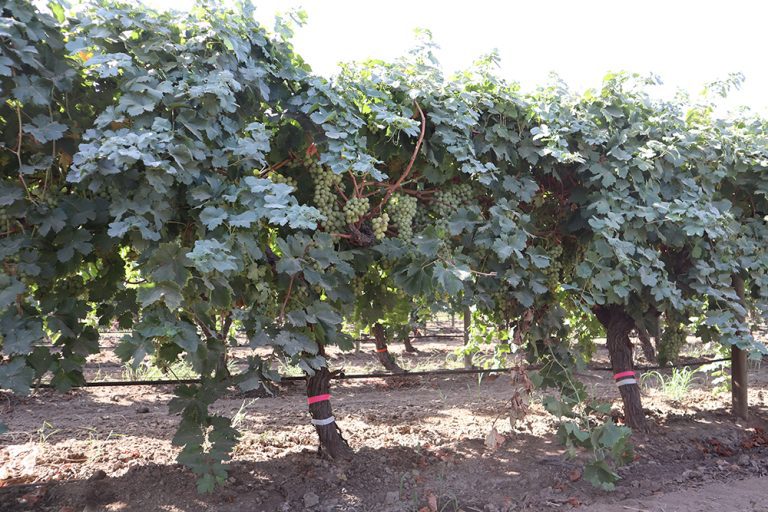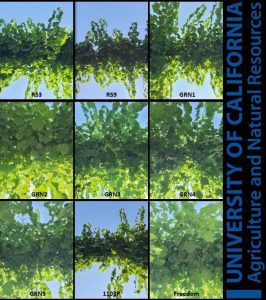
Vineyard rootstocks find water, scions spend water.
The relationship between the two needs to work to produce grape yields and quality, but researchers know if drought conditions persist, rootstocks that can perform on less water must be developed.
Most grapevines are grafted on a rootstock, the underground part of the plant that supports growth aboveground. Grapevines are deeply rooted with more than 25% of root biomass typically distributed below one meter.
Luis Diaz Garcia, assistant professor in grape breeding in the Department of Viticulture and Enology at UC Davis said drought resistance research is ongoing, exploring different adaptive strategies in a variety of grape germplasm and developing novel approaches to screen drought tolerance traits more efficiently. Diaz Garcia said his laboratory is using genomics, robotics, proximal sensing and artificial intelligence to increase the efficiency in identifying superior-performing vines.
These approaches, he said, can increase the number of plants evaluated in the program and reduce the time it takes to find and test the new rootstocks.
Diaz Garcia explained there are several mechanisms by which a grapevine can tolerate drought. Those include closing its stomata (small pores on the surface of the leaves that facilitate gas exchange and transpiration) to prevent water loss, limiting growth and modifying its root architecture to explore more soil area and extract water.
“The challenge is not all of these adaptive mechanisms are compatible with vineyard production systems. Therefore, understanding these mechanisms is crucial for selecting the best/most informative traits to screen in breeding programs,” he said.
The goal of the UC research, Diaz Garcia explained, is to develop new rootstocks with improved water-use efficiency and other adaptive traits such as nematode tolerance and good grafting and rooting capabilities. New root traits that help with drought resistance have been identified by UC researchers.
Drought Responses
Megan Bartlett, Department of Viticulture and Enology, said with identification of these traits, they can be amplified in new grape varieties. A UC publication outlined her study findings. Contributing to her study were researchers from University of British Columbia and the USDA-ARS Crops Pathology and Genetics Research Unit.
Bartlett’s research focused on drought responses in living root cells. Capitance, a measurement of how much roots shrink as they dehydrate, is an important trait for drought tolerance. Water stress can cause roots to shrink and pull away from the soil, losing access to any soil water. When the scion is unable to replace the water lost to evaporation, the stomata are closed to prevent severe dehydration. However, this stops photosynthesis. Rootstocks with lower capitance maintained greater gas exchange under water stress, suggesting adjustment in root structure and biochemistry to retain greater root volume could improve belowground hydraulic function under drought conditions. Bartlett’s study was the first to test whether traits measuring root shrinkage and cell collapse can capture differences in rootstock drought tolerance.

Karl Lund, UCCE viticulture advisor in Madera, Merced and Mariposa counties, said most of the work in drought tolerant rootstock development is focused on the winegrape segment as there is funding available. Bartlett’s study was supported by the American Vineyard Foundation, UC Davis and by private donations.
“What does drought tolerance mean?” Lund asked. “Is it when a rootstock is good at dealing with low irrigation like 70% of ET over the season, or is it the ‘broken pump’ problem where there is no water available for a period of time, and when it is, will the rootstock recover?”
Lund explained there is a lot of variation among rootstocks in how they handle water stress. Some, he noted, are good at mining water from the soil or can find water in the soil. An example is the GRN3 rootstock’s ability to find water.
One challenge to development of a new rootstock is time. Lund said with drought tolerance in mind, first you have to grow the plant, then it takes multiple years to determine its value as drought-tolerant. Field trials for drought tolerance are also difficult to do in wet years.
In comparison, a rootstock trial for nematode resistance takes six months to two years.
Use of genetic markers to make crossbreeding selections for rootstocks can speed up the process, but the rootstock’s performance in the field for crop yield and quality also must be considered.
Scion Plays a Part
The scion grafted to the rootstock also plays a part in drought tolerance. The rootstock may find the water needed for production, but it is the scion that decides when to open stomata for transpiration. Canopy size is also controlled by both the rootstock and the scion. Larger root systems handle drought by finding water, but they also support a larger canopy.
Lund said he has found situations where a drought-resistant rootstock develops a large canopy that can still handle water stress when the rootstock and scion work as a team. Some incompatibility issues between rootstocks and scions have arisen, but Lund said viruses may play a part in that.
When choosing a grapevine rootstock, Lund said the first question is how much tonnage do you want? That figure varies depending on the region. In the San Joaquin Valley, desired winegrape tonnage is high. In the wine country to the north, lower tonnage is preferred, he said. 7 tons to the acre is too much for winegrape growers in the Napa and Sonoma growing regions; they prefer about 3 to 5 tons per acre and desire a lower-vigor rootstock.






